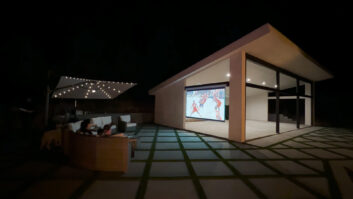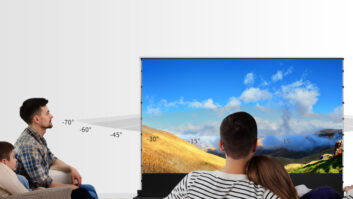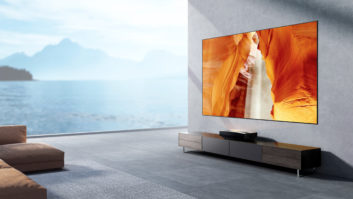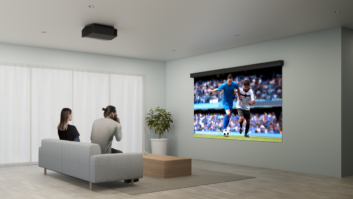When determining the right size screen and a projector for a private theater, basic client preference information is needed first. For instance, is the client primarily interested in movies, broadcast, games, or all of the above? And, how many people are intended for the theater and how many rows of seating will be required to seat the audience? If the client prefers movies, then a 2.35:1 or 2.40:1 native aspect ratio screen is the best choice. If the client watches a lot of sports, other broadcast media, or games, the native content is 1.78:1, and the screen should be sized for that configuration.

The single-row audience will all share approximately the same viewing distance and vertical viewing angle but will have a very different position, horizontally.
Size of Audience. A private theater audience of eight in a single row will provide a very different challenge than an audience of eight in two rows. The single-row audience will all share approximately the same viewing distance and vertical viewing angle but will have a very different position, horizontally. The two-row configuration results in two different viewing distances–two vertical viewing angles but similar horizontal positions. Generally we size the screen to provide the primary viewers the optimumviewing angle for the native aspect ratio selected. For instance, for a 2.40:1 image we try for a 43-degree viewing angle and for 1.78:1 at least a 33-degree angle (CEA/CEDIA CEB-23). In a multi-row theater, some seats may be closer, resulting in a wider viewing angle and some further away that would reduce that angle. Once the right size and shape is determined, there are a number of other considerations for selecting the appropriate screen. Some of these are: masking or no masking; acoustically transparent or not; curved or flat; screen gain/screen material; and 3D or not.
Room Dimensions. All projectors have operational limits of throw distance, and vertical and horizontal offset. It is important to calculate the throw distance for the screen and then the offset specifications, then “place” the projector into the room design, verifying that it will work on a number of levels. For instance, the projector must be within the throw distance and offset ranges (if using an anamorphic lens assembly, verify any modifications of offset). Also, for aesthetic reasons, you may want to house the projector in a soffit or custom furniture. Finally, some projectors, in order to drive the large screens with which we work, are also quite large. Make sure the projector can be placed, safely, so that it does not become a hazard.
Other projector considerations include:
1. Light output – once we know the screen size, material and the ambient light conditions of the room, we can calculate the required light output of the projector.
2. Contrast ratio – the standard to be used is the projected image system contrast ratio as it is a result of the projector and the screen, based on viewing conditions and content to be viewed.
3. Application – the addition of anamorphic lenses, motorized zoom and memory, presets, etc. may come into the decision process depending on the client’s application and budget.
4. Documentation and support – when selecting a projector, we always consider the availability of good documentation, including manuals, CAD files and technical support.
Sam Cavitt is president of Paradise Theaters in Hawaii and California.






